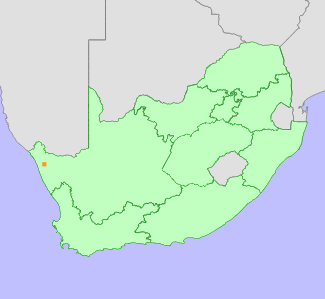|
Scientific Name | Conophytum bachelorum S.A.Hammer |
Higher Classification | Dicotyledons |
Family | AIZOACEAE |
National Status |
Status and Criteria | Critically Endangered A4ad; B1ab(v)+2ab(v) |
Assessment Date | 2021/11/18 |
Assessor(s) | A.J. Young, P.G. Desmet, I. Ebrahim, D. Guo, A. Harrower, L. Jabar, L. Knoetze, C. Rodgerson, P.C.V. Van Wyk & N.N. Mhlongo |
Justification | This dwarf succulent species is endemic to the Northern Cape province of South Africa where it is only recorded from a single location with an extent of occurrence (EOO) and area of occupancy (AOO) of 4 km². It has been increasingly targeted by illegal collection for the specialist succulent trade in recent years and there has been an almost complete loss (more than 90%) of the mature individuals from the only known small location due to illegal collection since 2019. The remaining plants are threatened as this is one of the most sought after species in the genus. Extinction in the wild is a real possibility within the next 10 years. The species has a generation length of at least 30 years and is especially vulnerable due to its limited geographic range and small population size. It therefore qualifies as Critically Endangered under criteria A4 and B1+2. |
Distribution |
Endemism | South African endemic |
Provincial distribution | Northern Cape |
Range | This species is endemic to a small part of the Northern Cape province of South Africa where it is only found in a single location with a severely restricted geographic range. |
Habitat and Ecology |
Major system | Terrestrial |
Major habitats | Namaqualand Heuweltjieveld |
Description | This species is endemic to the Namaqualand Hardeveld bioregion of the Succulent Karoo biome. Plants are only known from a single severely range-restricted locality on a quartz ridge in a remote area. They are typically found in part shade in cracks and crevices in large quartz boulders and amongst small quartz stones. This species has a generation length of 30 years. It is expected to be sensitive to the impacts of climate change as it does not disperse and while adapted to arid conditions, is dependent on limited seasonal rainfall. Species in the genus are sensitive to long periods of drought. Drought related mortality has been observed for other closely related taxa within the genus. |
Threats |
| This succulent is severely threatened by harvesting for the ornamental succulent trade and is close to extinction in the wild as a direct result. Monitoring of social media has shown that approx. 1000 mature individuals (representing >90% of the population) were collected illegally in 2021. This was later confirmed by a site survey. This species is only known from a single location and has very poor dispersal characteristics making the species very sensitive to such activity.
Anthropogenic climate change is a long-term threat to this species. While it is not possible to model the response of this species to climate change due to its restricted distribution, the average loss to climate change for 15 more widely distributed Conophytum species occurring within the same region is used as an indication of likely impact to this species. Climate models for the likely emission scenarios where emissions stay at present day levels (RCP 2.6) (Hausfather and Peters 2020) and worst case scenarios where emissions continue to increase during the 21st century (RCP 8.5) indicate that there will be a loss of suitable bioclimatic envelope of between 72% and 99% by 2080 for Conophytum taxa within the region. Species in this genus have limited dispersal ability and migration to suitable habitats elsewhere is regarded as highly unlikely. |
Population |
This species is highly localized on a small part of a quartz ridge. Previous estimates (2011, 2013) put the population size at 500-1,000 mature individuals. A site survey by the South African National Biodiversity Institute in 2021 found approx. 100 plants remaining following illegal collection for the succulent trade. This species is only known from a single location making the species very sensitive to such activity.
|
Population trend | Decreasing |
Assessment History |
Taxon assessed |
Status and Criteria |
Citation/Red List version | | Conophytum bachelorum S.A.Hammer | CR B1ab(v)+2ab(v) | 2020.1 | | Conophytum bachelorum S.A.Hammer | VU D1+2 | Raimondo et al. (2009) | |
Bibliography |
Hammer, S. 2002. Dumpling and his wife: New view of the genus Conophytum. EAE Creative Colour, Norwich.
Hammer, S.A. 1993. The genus Conophytum: A conograph. Succulent Plant Publications, Pretoria.
Hausfather, Z. and Peters, G.P. 2020. Emissions - the 'business as usual' story is misleading. Nature 577(618-620).
|
Citation |
| Young, A.J., Desmet, P.G., Ebrahim, I., Guo, D., Harrower, A., Jabar, L., Knoetze, L., Rodgerson, C., Van Wyk, P.C.V. & Mhlongo, N.N. 2021. Conophytum bachelorum S.A.Hammer. National Assessment: Red List of South African Plants version 2024.1. Accessed on 2025/12/30 |
 Comment on this assessment
Comment on this assessment


